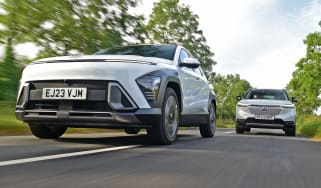Hyundai Kona review: award-winning small SUV is a fine choice
The new Hyundai Kona is comfortable, refined, spacious and overflowing with technology
The new Hyundai Kona is a fantastic example of how a brand can listen to feedback and act upon it. Hyundai has grown its small SUV sensibly, delivering just enough additional practicality to satisfy those looking for their next family car. To go along with the extra space is a far more polished cabin compared with the original Kona. It’s smart looking, logically laid out, and features an intuitive infotainment system.
Admittedly, the daring, sci-fi-inspired styling might not be for everyone, and there are cheaper compact SUVs out there, but right now the Kona – and the Kona Electric in particular – looks extremely good value for such a mature, well equipped and well-rounded car. It’s one of many reasons why we crowned the new Hyundai Kona as our Small SUV of the Year and overall Car of the Year for 2023.
Our choice: Hyundai Kona Electric Advance Comfort Pack
About the Hyundai Kona
The first Hyundai Kona arrived in 2018 and proved to be a big hit. Its funky styling certainly helped it stand out in the sea of small SUVs it was competing against, while the selection of petrol, hybrid and all-electric powertrains meant that there was a Kona to suit all tastes and almost every budget. There was even a fast version in the form of the Kona N. It had its flaws though, with the cramped rear cabin and relatively small boot being the things that irked us most.
More reviews
However, when it came to developing its replacement, Hyundai says it listened carefully to feedback from Mk1 Kona owners, and it shows. The all-new, second-generation Hyundai Kona is bigger, more spacious, and more practical than the original, thanks in part to it being built on the larger K3 platform that’s also used by the latest Kia Niro.
The Kona may have grown in size, but its key rivals remain the cream of the crop in the small SUV and crossover segment. Among them are the Ford Puma, Jeep Avenger, Peugeot 2008, Renault Captur, Skoda Kamiq and Volkswagen T-Roc, plus the Kona’s Niro sister car. A few of these are also offered with a choice of combustion and electric power, in the case of the Niro, Avenger, and 2008.
The Kona has stuck with the same choice of powertrains as its predecessor, which means entry-level models are powered by either a 1.0-litre or 1.6-litre four-cylinder petrol engine that can be paired with either a six-speed manual gearbox or a seven-speed dual-clutch automatic.
Next up is the Kona Hybrid. It uses a 1.6-litre Atkinson-cycle four-cylinder petrol engine and a six-speed automatic, assisted by a single electric motor and a modest 1.32kWh battery. As this is a full-hybrid, you don’t have to plug it anywhere to charge, but fuel economy is improved over the regular petrol variants.
Sitting pretty at the top of the range is the Kona Electric. There are two versions available: the standard-range model is powered by a 48.4kWh (useable) battery that’s good for 234 miles on a single charge, while the long-range 65.4kWh (also useable) battery Kona Electric goes even further, with a claimed maximum range of 319 miles. Like the rest of the Kona line-up, the EVs are front-wheel drive.
Once you’ve picked the model you want, there’s also the matter of trim levels; entry-level Advance (the only option for the standard-range 48kWh Kona Electric), sportier-looking N Line and N Line S, plus range-topping Ultimate spec. Pricier trims add luxuries like leather upholstery, a sunroof and a Bose stereo, but even the base Kona is generously equipped with a 12.3-inch digital driver’s display, large central touchscreen, Apple CarPlay, Android Auto, alloy wheels, keyless entry, parking sensors for the front and rear, plus a reversing camera.
There are various option packs available too, such as the Comfort Pack for the entry-level Advance Kona Electric, which adds heated front and rear seats, and a wireless charging pad. Lux packs are offered on N Line S for petrol, hybrid and electric Konas, and on Ultimate versions of electric and Hybrid models. This pack adds ‘Premium Relaxation’ front seats, driver’s seat memory settings, and remote smart park assist.
Prices for the regular petrol Hyundai Kona start from just under £26,000, rising to more than £33,500 if you get the top-of-the-range version with the more powerful 1.6-litre motor and seven-speed DCT auto. The Kona Hybrid has a starting price just north of £30,000, but can rise to over £34,000 if you want all the goodies that come with Ultimate trim.
Finally, the standard-range Kona Electric currently starts at a fiver under £35,000. Upgrading to the long-range model, with its bigger batteries and extra range, adds £3,600 to the Kona Electric’s price tag, bringing it to nearly £38,600. Top-of-the-range models are priced at over £43,000.
Frequently Asked Questions
Hyundai Kona Electric Ultimate long-term test
Art director Darren Wilson is currently running a Hyundai Kona Electric on our long-term fleet and it’s been love at first sight as the small SUV has hit the ground running. Darren already knew it was good from the fact it scooped our 2023 Car of the Year title, but he’s still been blown away by its all round ability.
Darren also loves the way it looks, no doubt helped by the fact the car was designed and engineered as an EV before anything else. Plus the interior is modern and packed with tech. A downside? Well the cold January temperatures meant the range dropped from over 300 miles to around 240 miles, but that should hopefully improve as the weather gets warmer. You can read the full long-term test here…
For an alternative review of the Hyundai Kona, visit our sister site carbuyer.co.uk...















_yu73yx_o2dhpb.jpg)










